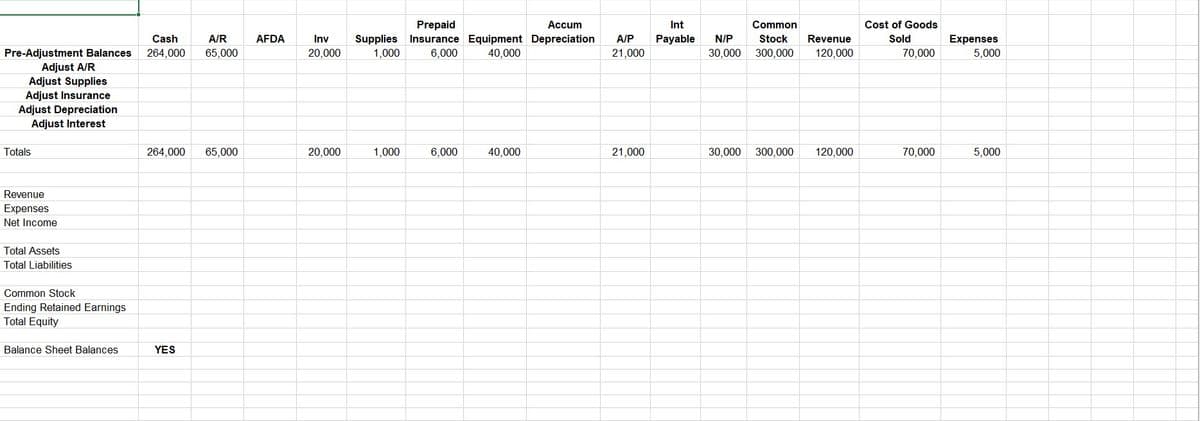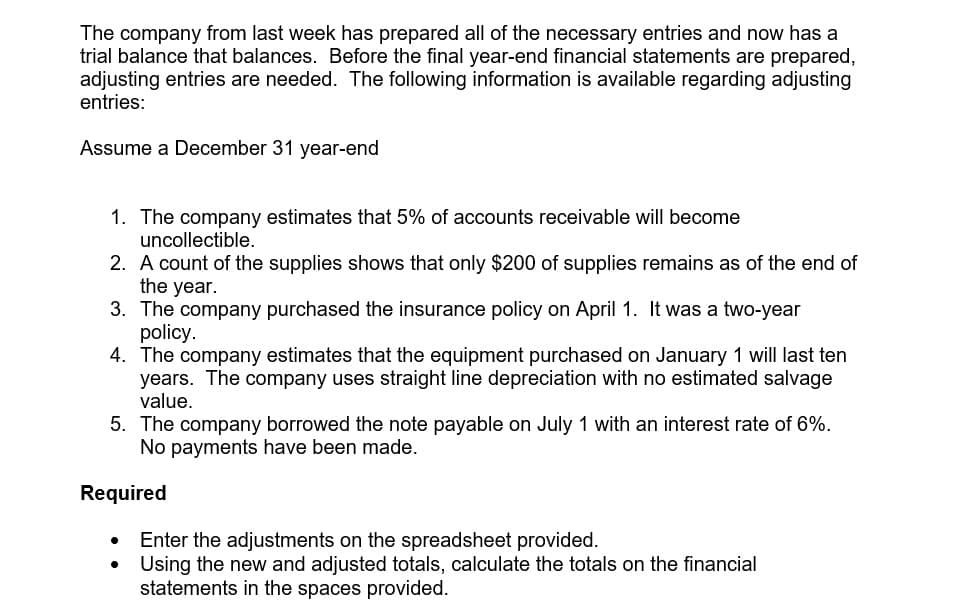The company from last week has prepared all of the necessary entries and now has a trial balance that balances. Before the final year-end financial statements are prepared, adjusting entries are needed. The following information is available regarding adjusting entries: Assume a December 31 year-end 1. The company estimates that 5% of accounts receivable will become uncollectible. 2. A count of the supplies shows that only $200 of supplies remains as of the end of the year. 3. The company purchased the insurance policy on April 1. It was a two-year policy. 4. The company estimates that the equipment purchased on January 1 will last ten years The company uses straight line depreciation with no estimated salvage
The company from last week has prepared all of the necessary entries and now has a trial balance that balances. Before the final year-end financial statements are prepared, adjusting entries are needed. The following information is available regarding adjusting entries: Assume a December 31 year-end 1. The company estimates that 5% of accounts receivable will become uncollectible. 2. A count of the supplies shows that only $200 of supplies remains as of the end of the year. 3. The company purchased the insurance policy on April 1. It was a two-year policy. 4. The company estimates that the equipment purchased on January 1 will last ten years The company uses straight line depreciation with no estimated salvage
Century 21 Accounting General Journal
11th Edition
ISBN:9781337680059
Author:Gilbertson
Publisher:Gilbertson
Chapter22: End-of-fiscal-period Work For A Corporation
Section: Chapter Questions
Problem 1AP
Related questions
Question
I need help with:
· Entering adjustments on the spreadsheet provided.
· Using the new and adjusted totals, calculate the totals on the financial statements in the spaces provided.

Transcribed Image Text:Prepaid
Accum
Int
Common
Cost of Goods
Cash
A/R
AFDA
Inv
Payable
Supplies Insurance Equipment Depreciation
1,000
A/P
N/P
Stock
Revenue
Sold
Expenses
5,000
Pre-Adjustment Balances
Adjust A/R
Adjust Supplies
Adjust Insurance
Adjust Depreciation
Adjust Interest
264,000
65,000
20,000
6,000
40,000
21,000
30,000
300,000
120,000
70,000
Totals
264,000
65,000
20,000
1,000
6,000
40,000
21,000
30,000
300,000
120,000
70,000
5,000
Revenue
Expenses
Net Income
Total Assets
Total Liabilities
Common Stock
Ending Retained Earnings
Total Equity
Balance Sheet Balances
YES

Transcribed Image Text:The company from last week has prepared all of the necessary entries and now has a
trial balance that balances. Before the final year-end financial statements are prepared,
adjusting entries are needed. The following information is available regarding adjusting
entries:
Assume a December 31 year-end
1. The company estimates that 5% of accounts receivable will become
uncollectible.
2. A count of the supplies shows that only $200 of supplies remains as of the end of
the year.
3. The company purchased the insurance policy on April 1. It was a two-year
policy.
4. The company estimates that the equipment purchased on January 1 will last ten
years. The company uses straight line depreciation with no estimated salvage
value.
5. The company borrowed the note payable on July 1 with an interest rate of 6%.
No payments have been made.
Required
Enter the adjustments on the spreadsheet provided.
Using the new and adjusted totals, calculate the totals on the financial
statements in the spaces provided.
Expert Solution
This question has been solved!
Explore an expertly crafted, step-by-step solution for a thorough understanding of key concepts.
This is a popular solution!
Trending now
This is a popular solution!
Step by step
Solved in 2 steps with 2 images

Knowledge Booster
Learn more about
Need a deep-dive on the concept behind this application? Look no further. Learn more about this topic, accounting and related others by exploring similar questions and additional content below.Recommended textbooks for you


Financial Accounting: The Impact on Decision Make…
Accounting
ISBN:
9781305654174
Author:
Gary A. Porter, Curtis L. Norton
Publisher:
Cengage Learning

College Accounting (Book Only): A Career Approach
Accounting
ISBN:
9781337280570
Author:
Scott, Cathy J.
Publisher:
South-Western College Pub


Financial Accounting: The Impact on Decision Make…
Accounting
ISBN:
9781305654174
Author:
Gary A. Porter, Curtis L. Norton
Publisher:
Cengage Learning

College Accounting (Book Only): A Career Approach
Accounting
ISBN:
9781337280570
Author:
Scott, Cathy J.
Publisher:
South-Western College Pub

Principles of Accounting Volume 1
Accounting
ISBN:
9781947172685
Author:
OpenStax
Publisher:
OpenStax College